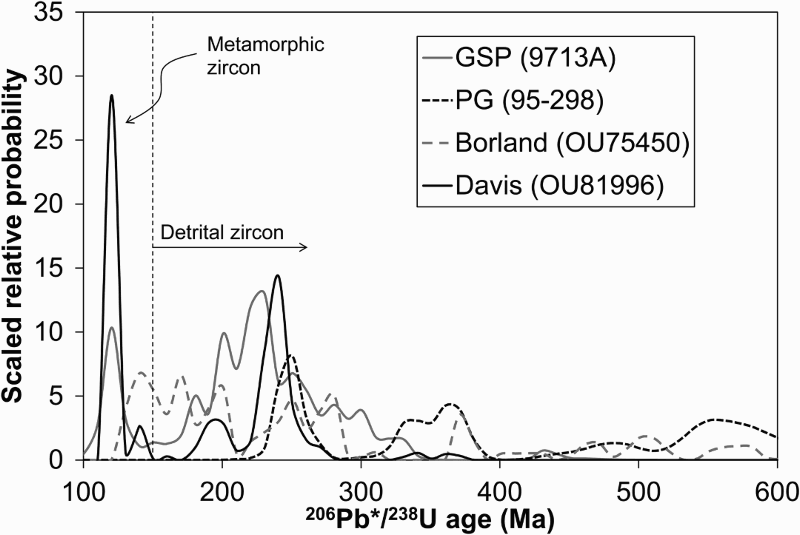Figures & data
Figure 1. A, Geological map of the Glenroy area, compiled from new field-mapping, Cutten (Citation1987), Campbell (Citation1992) and Rattenbury et al. (Citation2006). Topographic data sourced from the Land Information New Zealand (LINZ) Data Service, and licensed for re-use under the Creative Commons Attribution 3.0 New Zealand licence. Map coordinates refer to NZTopo50 map series. B, Schematic cross-section through the Matakitaki foreland thrust system illustrating the geometry of contacts between the fault-bound blocks (after Cutten Citation1987; Campbell Citation1992).
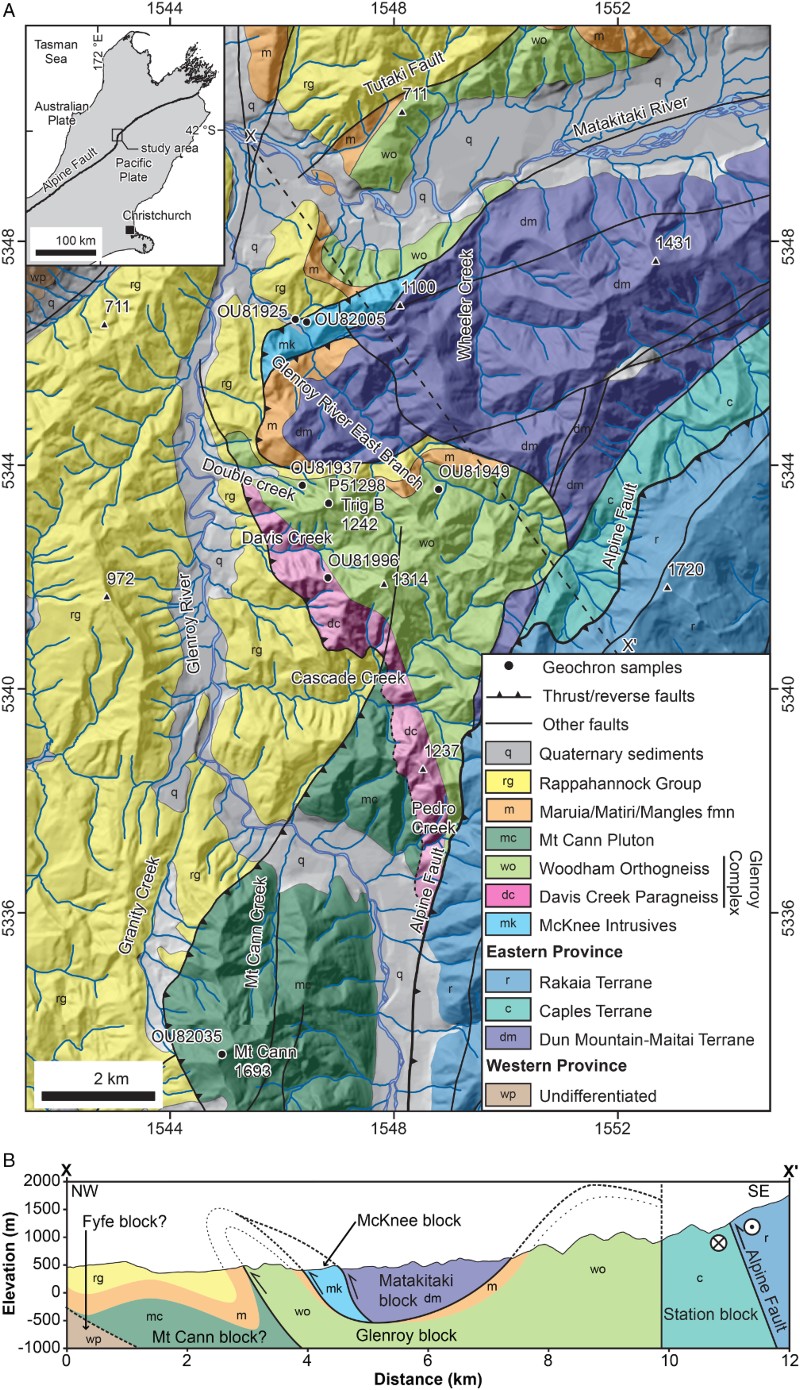
Figure 2. Plane-polarised light photomicrographs of (A, B) Woodham Orthogneiss hornblende-biotite monzodioritic orthogneiss and (C, D) McKnee Intrusives quartz monzodiorite (OU82005). A, Partial replacement of clinopyroxene and orthopyroxene by hornblende, biotite and quartz (OU81943). B, Incomplete replacement of ilmenite by titanite. Note the green-blue rims and green-brown cores of the hornblende (OU81910). C, Partial magmatic replacement of clinopyroxene by hornblende, which has in turn been partially altered to biotite. D, Textural evidence for sub-solidus replacement of biotite by muscovite, chlorite and epidote. Mineral abbreviations follow Whitney & Evans (Citation2010).
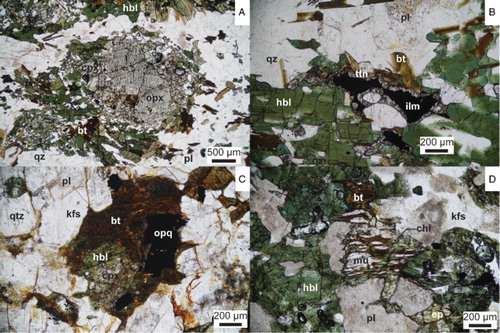
Table 1. Summary of the U–Pb zircon ages, suite affinity and whole-rock major- and trace-element data for representative samples of the Glenroy Complex, McKnee Intrusives and Mt Cann Pluton. Mineral abbreviations follow Whitney & Evans (Citation2010).
Figure 3. Cathodoluminescence images of zircon (left column), and combination stacked frequency histograms and Gaussian-summation probability density distribution plots of 206Pb*/238U zircon dates (right column) for: A–D, Woodham Orthogneiss (OU81949 and OU81937); E–H, McKnee Intrusives quartz monzodiorites (OU81925 and OU82005); I, J, Mt Cann Pluton quartz monzodiorite (OU82035). Asterisk indicates date is part of magmatic population.
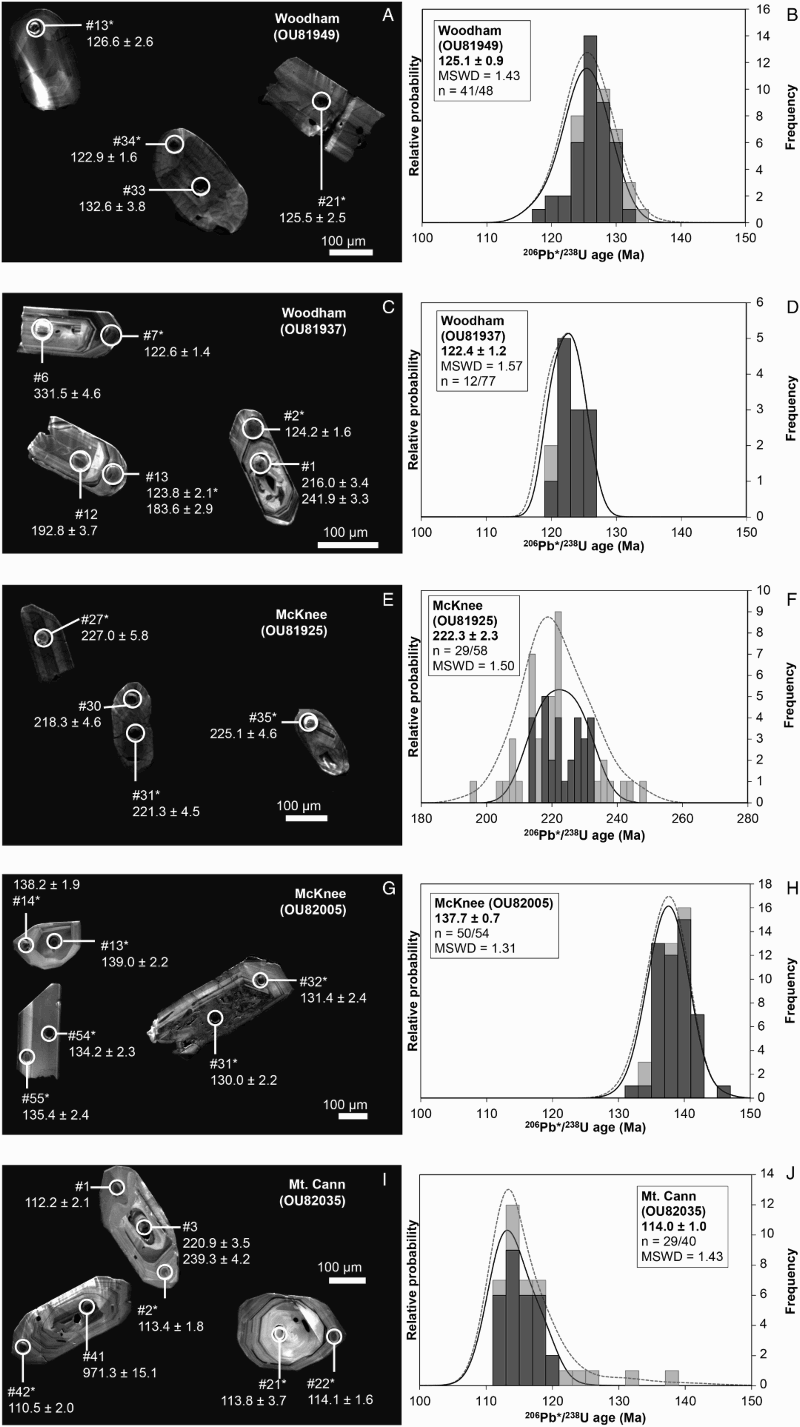
Figure 4. Davis Creek Paragneiss quartzofeldspathic gneiss (OU81996). A, Cathodoluminescence images of representative zircons. Asterisk indicates that the age is part of the metamorphic population. B, Combination stacked frequency histograms and Gaussian-summation probability density distribution plot. P (1/20) is the probability that a zircon population representing 5% of the zircons in the rock would be missed when analysing 76 grains at random (Dodson et al. Citation1988). C, Tera-Wasserburg concordia plot showing the 14 concordant analyses from the metamorphic population. Error ellipses are shown at the 1σ level. P = probability of concordance. Error on concordia age is 2σ. D, Th/U versus 206Pb*/238U age plot. The dashed line marks the minimum Th/U ratio (0.5) of typical magmatic zircon (Hoskin & Schaltegger Citation2003).
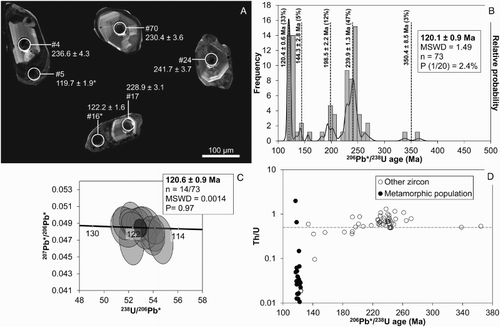
Figure 5. Whole-rock geochemical variation diagrams of the Woodham Orthogneiss compared to the Arthur River Complex (ARC), Separation Point Suite (SPS) and Western Fiordland Orthogneiss (WFO): A, Al2O3 versus SiO2; B, Na2O versus SiO2; C, Rb versus SiO2; D, log(Sr/Y) versus Y; E, chondrite-normalised (Sun & McDonough Citation1989) rare Earth element (REE) plot; F, stacked histogram of Sr/Y ratios. Main data sources: Bradshaw & Kimbrough (Citation1991); Challis et al. (Citation1994); Burgess (Citation2004); Blattner (Citation2006); Scott & Palin (Citation2008); Allibone et al. (Citation2009a); Allibone et al. (Citation2009b); Scott et al. (Citation2009a); Turnbull et al. (Citation2010b); Price et al. (Citation2011); Tulloch et al. (Citation2011); Daczko et al. (Citation2012); McCoy-West et al. (Citation2014). *Percentage of total WFO, including the Woodham Orthogneiss. **Other WFO excludes the atypical Breaksea Orthogneiss and Hawes Head Ultramafics.

Figure 6. Whole-rock geochemical variability of the Davis Creek Paragneiss compared to mean volcanic rock compositions, and average upper crust (McLennan Citation2001). A, F1–F2 discriminant function diagram (Roser & Korsch Citation1988). B, A–CN–K triangle (Fedo et al. Citation1995). *Apatite-correction applied (CaO = Ca – 1.67P). C, Th/Sc–Zr/Sc bivariate diagram (after Roser & Korsch Citation1999). D, Primitive mantle (PM) (Sun & McDonough Citation1989) normalised trace-element spider diagram. A, andesite; CAB, calc-alkaline basalt; D, dacite; R, rhyolite. Mineral abbreviations are those of Whitney & Evans (Citation2010).
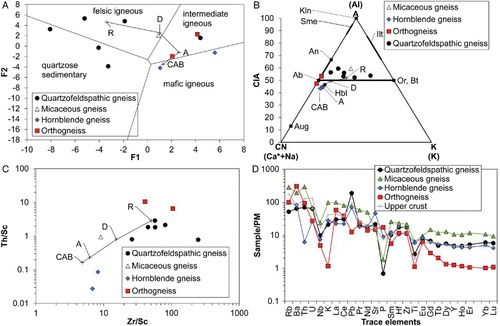
Figure 7. Whole-rock geochemical variation diagrams showing the McKnee Intrusives and Mt Cann Pluton compared to the Separation Point Suite, Rahu Suite and Darran Suite: A, Al2O3 versus SiO2; B, Na2O versus SiO2; C, Sr versus SiO2; D, Y versus SiO2; E, F, Chondrite-normalised REE plots. Data sources in addition to those listed for : Graham & White (Citation1990); Muir et al. (Citation1997); Waight et al. (Citation1998); Sagar & Palin (Citation2011). TR, Triassic; K, Cretaceous.
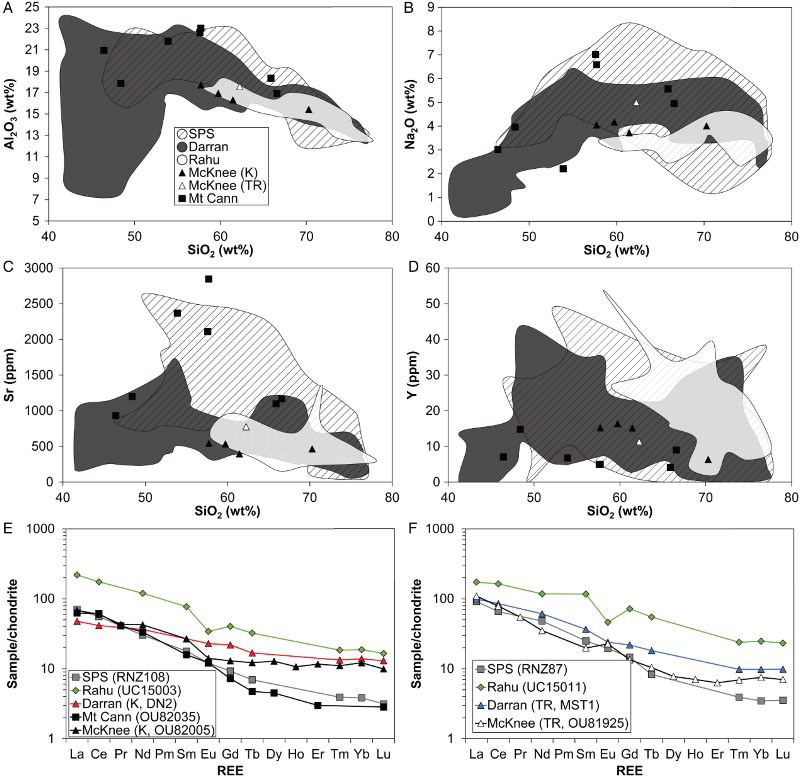
Figure 8. Plots showing the age ranges of A, Woodham Orthogneiss (OU81949, OU81937 and P51298) and WFO and Fiordland SPS plutons; B, Late Triassic McKnee Intrusives (OU81925) and Darran Suite plutons; C, Early Cretaceous McKnee Intrusives (OU82005) and Darran Suite plutons; D, Mt Cann Pluton (OU82035) and Nelson and Fiordland SPS and Rahu Suite plutons. Data sources: Kimbrough et al. (Citation1994); Muir et al. (Citation1994, Citation1997, Citation1998); Waight et al. (Citation1997); Blattner & Graham (Citation2000); Tulloch & Kimbrough (Citation2003); Hollis et al. (Citation2004); Klepeis et al. (Citation2004); Bolhar et al. (Citation2008); Scott & Palin (Citation2008); Allibone et al. (Citation2009a); Turnbull et al. (Citation2010b); Stowell et al. (Citation2014).
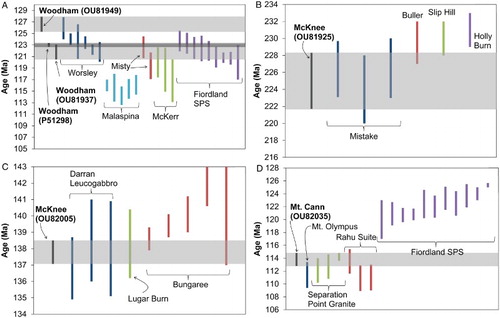
Figure 9. Simplified geological maps showing the tectonostratigraphic basement rock units of A, the South Island; B, the Glenroy area, southeast Nelson; and C, northern Fiordland. Fault-bound blocks of many of the basement units in northern Fiordland, including the WFO, GSP and Late Triassic and Early Cretaceous Darran Suite, that are exposed c. 100 km along the strike of the Alpine Fault crop out over only c. 10 km parallel to the Alpine Fault in the Glenroy River valley, southeast Nelson. The circled numbers indicate plutonic/gneissic basement units in northern Fiordland and southeast Nelson that have similar geochemistry and geochronology, and equivalent Eastern Province Terranes.
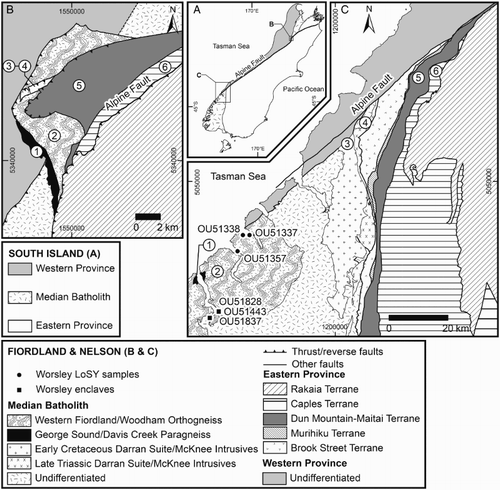
Figure 10. Gaussian-summation probability density distributions of zircon ages in the Davis Creek Paragneiss (OU81996) with those in the George Sound Paragneiss (GSP), Borland paragneiss and Parapara Group (PG). Data sources: Wysoczanski et al. (Citation1997); Clarke et al. (Citation2009); Scott et al. (Citation2009b).
